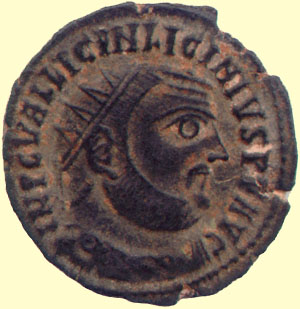 Contents -
Previous Article -
Next Article
Contents -
Previous Article -
Next Article
Like Diocletian and the Tetrarchs, Licinius I was a tough Illyrian soldier and, in the eyes of Galerius, an ideal choice for emperor in the West. Furthermore, Galerius needed someone in whom he could trust. Some of the augusti and caesars in the West had led rebellions recently and it looked like the empire was about to relapse into the civil war and anarchy that so characterized the Roman Empire during the Third Century.
In A. D. 308, Galerius called a peace conference at the northern military city of Carnuntum on the Danube. Maximianus was forced again to abdicate, Maxentius was declared an outlaw and public enemy, and Licinius was promoted to the rank of Augustus in the West. At the same time, Constantine was demoted to Caesar. Since Licinius had not spent any time as Caesar prior to his being made Augustus, both the Caesars, Maximinus Daia and Constantine, were angry. According to the way Diocletian had set up the Tetrarchy, any man who was to become Augustus in either the West or the East had to spend a period of apprenticeship as Caesar. To appease the two offended Caesars, Galerius had to finally promote them to Augusti a few years later.
The problem of dealing with Maxentius, the one remaining rebel, was still not resolved. Galerius, the emperor who had been taking the most vigorous action against Maxentius, died in A. D. 311. Maximinus Daia immediately moved his court to Nicomedia and declared himself Augustus and thus became the Roman Emperor Maximinus II.
In 312, Constantine formed an alliance with Licinius and went after Maxentius. On October 12, Maxentius was defeated and killed at the Milvian Bridge. Constantine, Licinius, and Maximinus II were left in control of the huge Roman Empire. Licinius and Constantine agreed to halt the persecution of Christians and in 313 issued the Edict of Milan, which guaranteed freedom to all people in the empire to worship as they saw fit. Maximinus II continued the persecutions in the territories he controlled, though. Maximinus was not to remain a problem much longer, however. He decided to invade Licinius’ territory and was quickly defeated after Licinius mobilized an army to go after him. Maximinus escaped disguised as a slave but died at Tarsus a few months later.
From A. D. 313 until 324, both Licinius and Constantine ruled the Roman Empire as Augusti. Both men were ambitious and always seeking more power, so it was only inevitable that there would be friction between them. They fought a couple of battles with no clear-cut victor, but later patched together a fragile peace. In 317, Constantine elevated two of his sons to the rank of Caesar, and Licinius did likewise with his son. Thus, beginning in that year, we see coins struck in the name of Licinius, Licinius II, Constantine, Crispus, and Constantine II. Constantine's two other sons by his second wife Fausta were made Caesars later.
In A. D. 324, Constantine and Licinius fought two battles after Licinius chased some barbarians into Constantine's territories. After losing at both Hadrianopolis and Chrysopolis, Licinius was finished as a Roman Emperor. Licinius' wife Constantia, who was also Constantine’s sister intervened and was able to persuade Constantine to spare the lives of Licinius and his son. However, they were soon discovered plotting to overthrow Constantine. Both men were executed on Constantine's order in A. D. 324.
Go to next article on Licinius II
Go back to previous article on Romulus